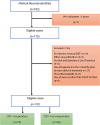Determinants of treatment response to cognitive behavioral therapy in veterans presenting with comorbid insomnia and sleep apnea
- PMID: 40085346
- PMCID: PMC11909029
- DOI: 10.1007/s11325-025-03298-z
Determinants of treatment response to cognitive behavioral therapy in veterans presenting with comorbid insomnia and sleep apnea
Abstract
Purpose: Although cognitive behavioral therapy for insomnia (CBT-I) is considered the preferred treatment for insomnia in patients with comorbid insomnia and obstructive sleep apnea (COMISA), the remission rate with CBT-I is generally considered lower than in insomnia-only populations. There is also a sizable variability in individual treatment responses. Due to the limited availability of CBT-I, we sought to identify specific clinical attributes that predict benefit from Brief Behavioral Therapy for Insomnia (BBTI)-an adaptation of CBT-I-in patients with COMISA.
Methods: We conducted a retrospective analysis of the National Veterans Health Administration (VHA) electronic medical records covering veterans diagnosed with COMISA between January 2021 and December 2023. Insomnia Severity Index (ISI) scores were recorded at baseline and after 12±1 weeks after BBTI. A positive response to BBTI was defined as a reduction in ISI score of ≥ 8 from baseline. A multivariate generalized linear model analysis was performed to delineate predictive factors of BBTI responsiveness.
Results: 131 eligible cases received BBTI over 6 weeks, 56 (43%) of whom did not respond. Non-whites (OR 3.5, 95% CI [1.4, 8.8]) and shorter sleep time (OR 0.98, 95% CI [0.98, 0.99] were independent predictors of blunted response to BBTI. These findings remained true even when depression and AHI were forced into the regression model. Patients with a total sleep duration of < 4.1 h were at greatest risk of being nonresponsive to BBTI.
Conclusion: These findings indicate that identifying insomnia phenotypes in patients with COMISA would help deliver personalized care while maximizing BBTI treatment resources.
Keywords: Cognitive behavioral therapy; Continuous positive airway pressure; Insomnia; Pharmacotherapy; Sleep apnea.
© 2025. This is a U.S. Government work and not under copyright protection in the US; foreign copyright protection may apply.
Conflict of interest statement
Declarations. Ethical approval: All procedures performed in this study involving human participants were in accordance with the ethical standards of the U.S. Department of Veterans Affairs and with the 1964 Helsinki declaration and its later amendments or comparable ethical standards. The study was approved by the Research and Development of the VA Western New York. Disclaimer: The views expressed in this article are solely those of the authors and do not reflect an endorsement by or the official policy of the U.S. Army, the Department of Defense (DoD), the Department of Veterans Affairs (VA), or the U.S. Government. This material is the result of work supported with resources and the use of facilities at the VA Western New York Health Care System. Conflicts of interest: No potential conflict of interests by the authors. All authors certify that they have no affiliations with or involvement in any organization or entity with any financial interest (such as honoraria; educational grants; participation in speakers’ bureaus; membership, employment, consultancies, stock ownership, or other equity interest; and expert testimony or patent-licensing arrangements), or non-financial interest (such as personal or professional relationships, affiliations, knowledge or beliefs) in the subject matter or materials discussed in this manuscript.
Figures
References
-
- Meira ECM, Kryger MH, Morin CM, Palombini L, Salles C, Gozal D (2021) Comorbid insomnia and sleep apnea: mechanisms and implications of an underrecognized and misinterpreted sleep disorder. Sleep Med 84:283–288 Epub 2021/07/03. 10.1016/j.sleep.2021.05.043 - PubMed
-
- Guilleminault C, Eldridge FL, Dement WC (1973) Insomnia with sleep apnea: a new syndrome. Science 181(4102):856–858 Epub 1973/08/31. 10.1126/science.181.4102.856 - PubMed
-
- Lichstein KL, Riedel BW, Lester KW, Aguillard RN (1999) Occult sleep apnea in a recruited sample of older adults with insomnia. J Consult Clin Psychol 67(3):405–410 Epub 1999/06/16. 10.1037//0022-006x.67.3.405 - PubMed
-
- Sweetman AM, Lack LC, Catcheside PG, Antic NA, Chai-Coetzer CL, Smith SS et al (2017) Developing a successful treatment for co-morbid insomnia and sleep Apnoea. Sleep Med Rev 33:28–38 Epub 2016/07/13. 10.1016/j.smrv.2016.04.004 - PubMed
MeSH terms
Grants and funding
LinkOut - more resources
Full Text Sources
Medical




